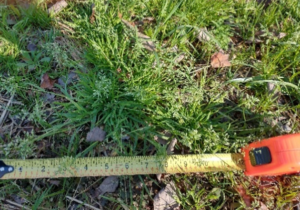By Heather N. Kolich, ANR Agent, UGA Extension Forsyth County, January 2022
We all know the adage that nature hates a void. Bare soil is one of those voids that nature will fill. To assist in this purpose, plants have adapted to survive and thrive in many difficult environments. When these plants show up in our lawns, pastures, and gardens, we call them weeds.

Types of weeds
Identification is the first step in controlling unwanted plants in cultivated spaces. We can narrow the options down with some simple classifications: season (summer or winter) and type (broadleaf or grass/grass-like). Let’s look at some of the common winter weeds out there now.
Common broadleaf winter weeds

Chickweed (Stellaria media) is a mat-forming annual with small, white flowers at the ends of stems. It spreads outward from the center. When hand weeding, reach under the stems to the central point and pull up from there to remove the entire mat. For chemical control, products containing 2,4-D + MCPP + dicamba give good control and are safe to use in most turfgrasses.
Carolina geranium (Geranium carolinianum) is a semi-erect annual weed with pink to purple flowers and deeply divided leaves at the ends of long petioles. This is also known as crane’s-bill or stork’s-bill because of the shape of the fruit capsule


Henbit (Lamium amplexicaule) is a very common winter annual weed. It bears narrow, purple flowers on green or purple, 4-sided stems. Chemical control is the same as for chickweed.

Musk thistle (Carduus nutans) is a winter annual or biennial with sharp spines at the tips of leaves and on flower bracts. For control, remove thistle with a shovel before it flowers.

Common grass or grass-like winter weeds Annual bluegrass (Poa annua) is probably the most recognizable winter grassy weed. Its round, bright-green clumps are quickly topped by light-green to white spikelets bearing small, white flowers. The flowers then produce seeds that fall into the lawn to ensure a new crop of annual bluegrass next winter. Control methods include frequent mowing to prevent seedhead formation, hand removal (ideally before seeds form), and spot spraying; however, the chemicals most effective for controlling actively growing annual bluegrass can also injure several types of lawn turfgrasses. Emerged Poa annua growing in dormant bermudagrass can be spot-treated with glyphosate. See Annual Bluegrass Control in Residential Turfgrass for more information
Annual weed control
What these featured weeds have in common is that they are annual, as opposed to perennial, weeds. That’s good news because annual weeds have only one means of reproduction: seeds. Frequent mowing to remove flowers and hand removal of the entire weed before it matures enough to be able to flower are effective for control of emerged weeds, with the important benefit of preventing these weeds from dropping seeds to germinate next year.
Unfortunately, previous crops of annual weeds may have built up a seed bank in the immediate growing area. Additionally, visiting birds and animals can drop weed seeds into our yards. These seeds can lie dormant, often for several years, just waiting for the environmental conditions they need to germinate.
That’s where our second line of defense, pre-emergence herbicides, enter the field. They actually need to enter the field twice each year.
When to apply pre-emergent herbicide
A pre-emergent herbicide acts on plant seeds to halt the germination process. That’s why it’s important to apply the product to the lawn area before the season of growth begins. As noted earlier, we have two seasons for annual weeds: cool season and warm season. Cool season (winter) weeds grow from late fall to early spring, and warm season (summer) weeds grow from late spring to early fall. To reduce the germination success of weed seeds, established lawns need a pre-emergence herbicide application twice each year.
Because warm season weeds can begin germinating when soil temperatures reach 55˚ Fahrenheit, apply a pre-emergence herbicide in late-February to mid-March. To control winter weeds in North Georgia, apply a pre-emergent as early as late August but before the end of September. Pre-emergent herbicides continue working in the soil for several weeks. For some pre-emergence chemicals, a second application 8 to 10 weeks after the initial treatment is permissible.
Important to note!
Pre-emergence herbicides disrupt germination in all types of seeds. They should only be applied to established lawns. Additionally, certain herbicides – both pre-emergence and post-emergence products – can cause injury to some types of turfgrasses. For example, atrazine damages bermudagrass. Always read and follow the label directions when using pesticides. The Georgia Pest Management Handbook, Home and Garden Edition, is a good resource to find the appropriate herbicide to control specific weeds in different species of turfgrass, as well as information about pesticides used to control weeds, diseases, and insects in lawns, gardens, and homes.